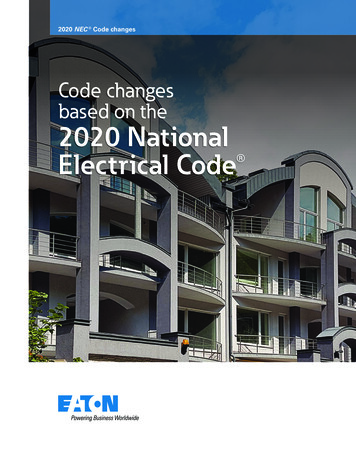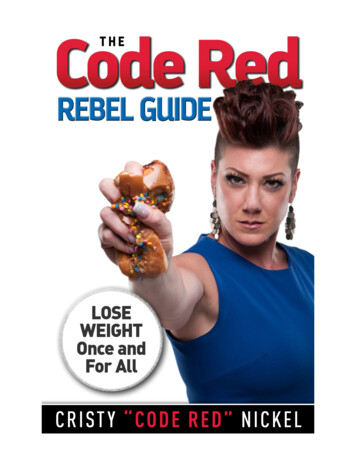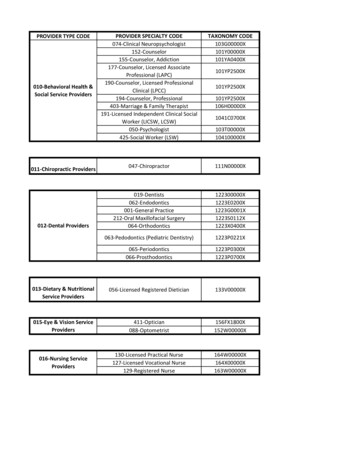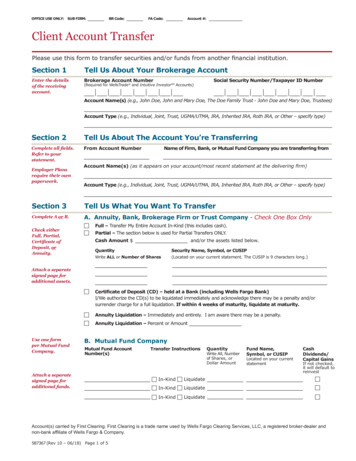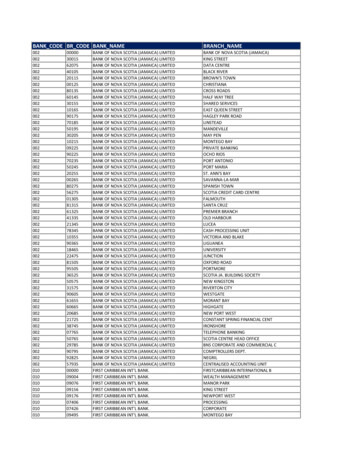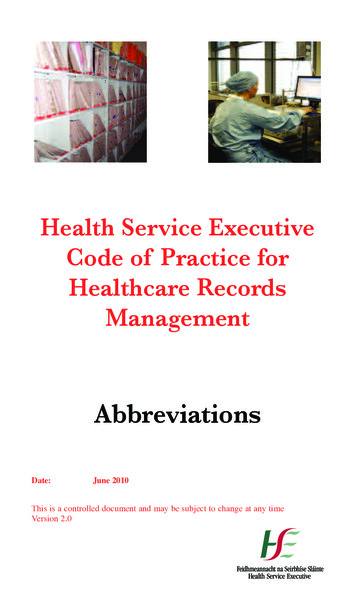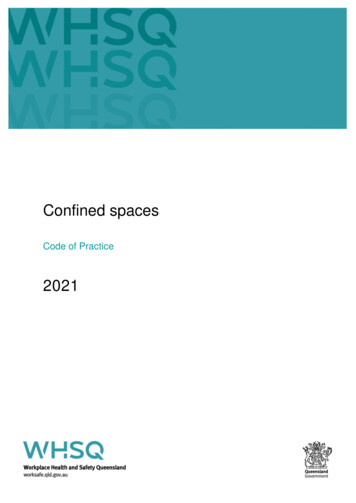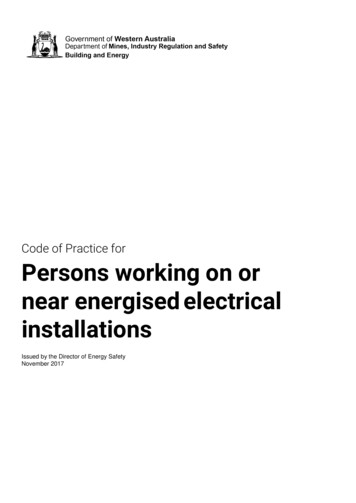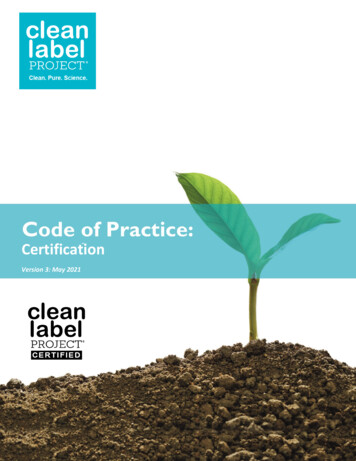
Transcription
CertificationVersion 3: May 2021
Clean Label Project Code of Practice: CertificationMay 2021The Clean Label Project is a national non-profit with themission to bring truth and transparency to consumer productlabeling. Using actual retail sampling and testing, weestablish evidence-based benchmarks to identify theAmerica’s best products using data and science as opposedto marketing.Together, we are changing the definition of food andconsumer product safety in America.1 PageCopyright 2021 by Clean Label Project All rights reserved.
Clean Label Project Code of Practice: CertificationMay 2021This Clean Label Project Code of Practice: Certification is subject to revision.Go to www.cleanlabelproject.org to confirm the current version.Questions, clarification, interpretations, and suggested revisions regarding this Code of Practice:Certification may be provided in writing to:Clean Label Project280 E. 1st Ave. #873Broomfield, CO 80038-0873E-mail: info@CleanLabelProject.org2 PageCopyright 2021 by Clean Label Project All rights reserved.
Clean Label Project Code of Practice: CertificationMay 2021Date of Publication: May 2021Published by:Clean Label Project280 E. 1st Ave. #873Broomfield, CO 80038-0873Copyright 2021 by Clean Label ProjectAll rights reserved.3 PageCopyright 2021 by Clean Label Project All rights reserved.
Clean Label Project Code of Practice: CertificationMay 2021Objectives and DisclaimersThis Code of Practice provides criteria for the evaluation and marketing of manufacturers seekingcompliance and certification for their products to the Clean Label Project Code of PracticeCertification. The implied compliance, evaluations, and the contents contained within are limitedexclusively to meeting the minimum requirements for the Clean Label Project Code of PracticeCertification. It is the responsibility of the Operator to comply with all applicable state, national,and international laws such as, but not limited to, California Prop 65, FDA food labeling laws, FDAfood safety laws, FDA pesticide tolerance level requirements, Country of Origin labeling, Tobacco,Tax, and Trade Bureau Laws, and USDA National Organic Program requirements, as applicable.It is also the responsibility of the Operator to comply with any applicable voluntary third-partyprivate schemes such as, but not limited to Organic, Fair Trade, and Global Food Safety Initiativebenchmarked standards.In no way does compliance to this Clean Label Project Code of Practice- Certification implycompliance to any other state or federal regulation or private standard. The Clean Label Projectdoes not assume, displace, or undertake to discharge any obligations or responsibilities of themanufacturer or any other party, including but not limited to those responsibilities and obligationsarising from the other certifications or standards referenced within this Clean Label Project Codeof Practice- Certification. Under no circumstances shall Clean Label Project or any of its affiliatesbe liable for direct, indirect, incidental, consequential, special, punitive or any other use of thisClean Label Project Code of Practice- Certification. This Clean Label Project Code of PracticeCertification may be revised from time to time.Use of this Clean Label Project Code of Practice - Certification is strictly voluntary.4 PageCopyright 2021 by Clean Label Project All rights reserved.
Clean Label Project Code of Practice: Certification Clean Label ProjectMay 2021Version 3Code of Practice - CertificationI.PurposeConsumers are increasingly concerned about the chemicals of concern and industrial andenvironmental contaminants in the food and consumer products they purchase for themselvesand their families. Issues like glyphosate in America’s best-selling beer and wine1, arsenic inAmerica’s best-selling bottled waters2, heavy metals in America’s best-selling baby foods3,and plasticizers in America’s best-selling protein powders4 fuels and validates this concern.The foundation of Clean Label Project is rooted on bringing truth and transparency toconsumer product labeling through the use of data and science. Through category specificbenchmarking, Clean Label Project establishes superiority thresholds and rewards brandswith products with overall results in the top 33% of their category. However, Clean LabelProject has a limited number of categories currently benchmarked. The Clean Label ProjectCode of Practice: Certification looks to establish pass/fail criteria for brands with products incategories that Clean Label Project has not yet benchmarked but still want to communicatetheir commitment to product purity.The purpose of the Code of Practice: Certification is to:1. Provide a market tool and evaluation criteria for growers, suppliers, manufacturers,brand owners, and retailers to begin identifying, evaluating, and maximizing puritywithin their products2. Create a market opportunity for manufacturers looking to communicate thiscommitment to consumers3. Satisfy the growing consumer demand for transparency through an on-packagemarket solution that is backed by testing and data4. Get back to the basics and provide consumers assurance and trust by lookingbeyond the flashy marketing because sometimes what’s not on the label is themost important5. Create a standard with chemicals of concern and industrial and environmentalcontaminant sampling and testing requirementsII.ScopeGrowers, manufacturers, co-manufacturers, brand owners, and retailers are eligible to applyfor the Clean Label Project Code of Practice- Certification.This Code of Practice- Certification outlines compliance documentation and marketingrequirements and guidelines.III.LimitationsThe contents of this document require producing documentation demonstrating complianceto certain minimum applicable food safety standards. This Code of Practice does notconstitute a guarantee of 100% of products are compliant to the stated limits. There is inherentvariability in consumer-packaged goods batches, loads, and runs. However, QA programsthat adhere to “best practices” should deliver high levels of consistency. There is a certain5 PageCopyright 2021 by Clean Label Project All rights reserved.
Clean Label Project Code of Practice: CertificationMay 2021percent error that is assumed using analytical chemistry instrumentation at low detectionlevels. These shall be accounted for during the compliance evaluation g/files/reports/WEB CAP Glyphosate-pesticide-beer-and-wine REPORT afety/heavy-metals-in-baby-food/4 -hidden-dangers-of-protein-powdersDefinitionsA. Administrator: the organization(s) contractually responsible for the Clean Label ProjectCode of Practice- Certification implementation and oversightB. Certification: An Operator that has been formally recognized by the Administrator asfulfilling the requirements as outlined in the Clean Label Project Code of PracticeCertificationC. Non-Compliant: Nonconformance to established requirements within the Clean LabelProject Code of Practice- CertificationD. Operator: the organization, business, entity, or person(s) responsible for Clean LabelProject- Certification compliance oversightV.Compliance FrameworkA. Initial Compliance Requirements1. Proof of Food Safety/Good Manufacturing Practices (GMP) ComplianceFood safety and/or good manufacturing audits are now a normal andnecessary component within the food and consumer product supply chain. AnOperator shall provide proof of food safety or GMP compliance. Examples offood safety compliance include, but are not limited to, proof of certificationunder a Global Food Safety Initiative benchmarked standard or proof ofcompliance to other third-party specified food safety or GMP standards.Standards such as USDA National Organic Program, Kosher, or another foodquality/marketing standard shall not be deemed sufficient.Proof of Food Safety/GMP Compliance documentation shall be dated withinthe past 18 months. The location listed on the Proof of Food Safety Compliancedocumentation shall match the location of product manufacture disclosed onapplication documentation. If an Operator uses multiple co-packers or comanufacturers, proof of food safety shall be supplied for each location.6 PageCopyright 2021 by Clean Label Project All rights reserved.
Clean Label Project Code of Practice: CertificationMay 2021Disclosure of a recall or any governmental inquiry such as Californiagovernment inquiry into California Proposition 65 compliance shall bedisclosed.2. Product SpecificationsThe purpose of creating a product specification is to clearly define therequirements of a final product. Strictly following product specifications isnecessary to control the quality, safety, and consistency of products. Foodproduct specifications can include information like allergens, Brix, and othergeneral and specific requirements as well as acceptable performancerequirements. Other consumer packaged goods product specifications mayinclude pH, viscosity, color, odor and other general and specific requirementsas well as acceptable performance requirements.To ensure ongoing compliance to the Clean Label Project Code of Practice,Operators should incorporate maximum impurities/contaminant tolerancethresholds for raw materials, in-process, or finished productspurchased/sourced from suppliers.Contaminants that shall be evaluated by the Administrator based on producttype are listed in VII.C.Tolerance levels shall align with Clean Label Project limits as listed in VII.B.3. Established Standard Operating Procedure for Supplier TestingThe purpose of a Supplier Quality Assurance Program is to ensure a supplier’sability to deliver on a good or service that will satisfy the customer’s needs. ASupplier Quality Assurance Program can be an effective means to control thequality of incoming products or materials and ensure the products meetnecessary specifications.To ensure ongoing compliance to the Clean Label Project Code of Practice,Operators should have a Standard Operating Procedure in place to specify if:1) The Operator will have the supplier perform compliance testing and/or2) The Operator will perform independent testing as a condition ofaccepting the incoming material or in recognition that the finishedproduct must comply with maximum tolerance levels as established bythe Clean Label ProjectThe Standard Operating Procedure should include provisions for situationssuch as the following:1) An Operator may elect to perform routine testing on all new and currentsuppliers7 PageCopyright 2021 by Clean Label Project All rights reserved.
Clean Label Project Code of Practice: CertificationMay 20212) An Operator may elect to utilize a risk assessment to identify high riskingredients or suppliers to minimize costs and optimize testingefficiency3) An Operator may choose to do independent testing for some suppliers,and allow other suppliers to perform their own testing and supply thetest results4. Proof of Finished Product Test ComplianceFinished product testing is at the foundation of the Clean Label Project Codeof Practice: Certification.All products seeking Clean Label Project Code of Practice certification shallpass a test to ensure compliance to the Clean Label Project tolerancesestablished in VII.1) Bracketing – In some cases, test bracketing may be utilized. Bracketing isthe concept of using a representative sample (in many cases, the worstcase scenario) for purposed of identifying a sample who’s test result maybe representative of multiple products. Bracketing options shall beevaluated on a case-by-case basis and shall include and assessment bythe Technical Administrator of the following:a. A comparison of the base formulations for the sample setb. An evaluation of internal testing proceduresc. An Operator’s track record of continued compliance with this Codeof Practiced. The Operator shall fill out an affidavit attesting to the accuracyformulation base and inform the Technical Administrator if there areany changes to the product formulation that may increase thevariability in the formulation compared to the sample sete. In instances where the Operator is white labeling, co-manufacturingor making a product in multiple sizes, this section shall apply.2) The Technical Administrator may charge for the administrative nature ofthe certification and bracketing process.B. Renewal/Ongoing ComplianceAll requirements outlined in Section VI. A apply. However, it should be noted thatthe Administrator of the Clean Label Project will perform testing at the Operator’sexpense. It is recommended that the Operator perform routine finished producttesting to ensure ongoing compliance with the Clean Label Project Code ofPractice- Certification.The Administrator of the Clean Label Project shall annually confirm proof ofcompliance with Section VI. A.It should be noted that the Clean Label Project Code of Practice- Certification is aliving document. The requirements and scope of testing will be revisited on a8 PageCopyright 2021 by Clean Label Project All rights reserved.
Clean Label Project Code of Practice: CertificationMay 2021regular basis and proactively communicated to Operators. Operators shall beprovided a minimum of 1-year implementation period when changes are made tothe Clean Label Project Code of Practice- Certification.VI.Administrator RequirementsA. Testing Requirements1. The Administrator of the Clean Label Project shall perform the testingassociated with Clean Label Project- Certification compliance as outline in VII.2. The Administrator shall perform random and unannounced sampling andtesting of products. The Administrator may elect to perform risk-based testing.The cost of testing shall be borne by the Operator.3. The Administrator shall inform Operators of their respective test results. If theAdministrator tests a product resulting in a non-compliant test result (deemedas greater/less than 30% of the established limit), the Administrator shall informthe Operator in writing of the test results. To continue to comply with the CleanLabel Project Code of Practice, the Operator shall perform a root causeanalysis to determine the source of the non-compliant test result within 30 daysof the non-compliant test result. This root cause analysis and corrective actionplan shall be supplied to the Administrator in writing. The Administrator shallreview the root cause analysis and corrective action plan and determine ifacceptable. The Operator should expect additional Administrative surveillanceof this product.4. In the event of a Non-Compliant test result, the Administrator reserves the rightto perform increased surveillance testing on the product and brand to ensureongoing compliance with the Clean Label Project Code of PracticeCertification requirements. The cost of this testing shall be borne by theOperator. The Operator may elect to perform increased surveillance testing onthe ingredient/supplier in question.B. Accreditation Requirements1. The Administrator shall maintain ISO 17025 laboratory accreditation to ensuretest result accuracy, consistency, team member training and best practice.2. The Administrator shall remain in good standing with its ISO 17025accreditation.3. The Administrator may elect to outsource testing to a designated third-partylaboratory if the scope of testing is outside its expertise. Any contract laboratorymust provide proof of laboratory consistency, competency, and accuracy bestpractice, such as proof of ISO 17025 for the specified scope/matrix.9 PageCopyright 2021 by Clean Label Project All rights reserved.
Clean Label Project Code of Practice: CertificationMay 2021C. Sampling Requirements1. The Administrator shall sample products by simulating the consumer shoppingexperience. The Administrator shall procure enough sample to fulfill testingneeds. This may only require that one sample be selected for testing.2. The Administrator shall ideally procure samples through local or onlineretailers. If not feasible, only in extreme circumstances shall the Administratorprocure samples from the Operator’s website or the Operator. In that specificcircumstance, the sample provided by the Operator must be in a finishedsealed (unopened) package that would be sold at retail. The cost of thesamples shall be borne by the Operator.3. Where applicable and feasible, the Administrator shall prepare/dilute samplesin accordance with Operator packaging instructions.4. The Administrator shall retain a picture of the product purchase, the lot number,and the receipt that shows the date, location, and retail of purchase. Thisinformation shall be provided to the Operator for purposes of root causeanalysis, investigations, and continuous improvement.D. Marketing Compliance Requirements1. The Administrator shall be responsible for maintaining and publishing the listof all products bearing the Clean Label Project Certification Mark on the CleanLabel Project website.2. Any product not meeting the requirements outlined in the Clean Label ProjectCode of Practice Sections VI.A, VI.B, or preventing the Administrator fromfulfilling its requirements outlined in VII shall be found to be non-compliant withthe Clean Label Project Code of Practice-Certification and issued a NonCompliance.3. In the event that a Non-Compliance goes unmitigated in excess of 90 days, theClean Label Project will remove the product from the online listing and issue anotification that the product has been dropped from listing. Additional adverseaction may be executed if the Operator continues to use the Clean LabelProject certification mark on the dropped product.4. The Administrator shall confirm the Operator’s compliance to the Mark UseRequirements outlined in the Brand Standard.E. Other Requirements1. In the process of ensuring compliance to the Clean Label Project Code ofPractice, the Clean Label Project provides necessary authority to theAdministrator to require additional testing, surveillance, or documentationrequests as deemed necessary.10 P a g eCopyright 2021 by Clean Label Project All rights reserved.
Clean Label Project Code of Practice: CertificationMay 20212. The Administrator shall maintain strict confidentiality of all Operator’sdocumentation and test reports.VII.Testing RequirementsA. Current Analytical Equipment Administrator RequirementsAssayHeavy MetalsPanelPesticides ScreenBPA/BPSAntibiotic ScreenResidual SolventsPhthalates PanelMycotoxinsAcrylamideParabensExpandedPesticide , Cadmium, Lead, MercuryICP-MS4 ppbVarietyBPA, BPSTetracycline, Ampicillin1,2-Dichoroethane, 2-Propanol, Acetone,Acetonitrile, Benzene, Chloroform,Cyclohexane, Diethyl Ether, Ethanol, EthylAcetate, Heptane, Hexane, m/p-Xylene,Methanol, Methylene Chloride, o-Xylene,Pentane, Toluene, Trichloroethene,Isobutane, n-Butane, n-PropaneLC-MSMSLC-MSMSLC-MSMS10 ppb40 ppb10 ppbGC-FIDUSP LimitsBenzyl Butyl, Dibutyl, Dihexyl, Bis (2ethylhexyl)Aflatoxin G2, Aflatoxin G1, Aflatoxin B2,Aflatoxin B1, Ochratoxin AAcrylamideMethyl, Ethyl, Isopropyl, Propyl, Total Butyl,BenzylGC-MSMSLC-MSMS200 ppbLC-MSMS10 ppbLC-MSMS40 ppbLC-MSMS500 ppbGlyphosateLCMS-MS100 ppb1*LOD/LOQ subject to change depending on complexity of matrix1See Appendix 1 for details of the PanelB. Current Tolerance Limit mum Tolerance Limit (µg/day)0.06 (inhalation) 10 (exceptinhalation) (µg/day)4.1 (oral), 0.05 (inhalation) (µg/day)0.5 (µg/day)0.3 (µg/day)Total PesticideVariesArsenic6,7BPA/BPSAntibiotic Screen11 P a g e3 (dermal exposure from solidmaterials) (µg/day)Non-DetectSource/InspirationEPA Arsenic in Drinking Water Standard1California Proposition 652California Proposition 652California Proposition 652Code of Federal Registrar Pesticide ChemicalTolerance Levels for Food3California Proposition 652FDA Food Safety and Inspection Service5Copyright 2021 by Clean Label Project All rights reserved.
Clean Label Project Code of Practice: CertificationResidual SolventsPhthalates PanelMycotoxinsAcrylamideGlyphosate(pesticide)May 20210.2 (µg/day)VariesNon-Detect0.2 (µg/day)California Proposition 652California Proposition 652California Proposition 652California Proposition 6521100 (µg/day)California Proposition .ecfr.gov/cgi-bin/text idx?SID a3b649316ccb17c31211db2edd81f789&mc true&node pt40.24.180&rgn -organic-program12Note: For pet-based products, AAFCO requirements shall apply. To ensure efforts to minimize ingredient and manufacturingcontamination, the USDA National Organic Program of utilizing 5% of the tolerance level and/or Prop 65 maximum tolerances shallbe used.C. Testing Requirements by alsProtein BarsDietary SupplementsSun Residual aby Personal tesBPA/BPSMetalsPesticidesPhthalatesSupplement esidual SolventsPesticidesLabel claim audit basedWhere applicable3AAFCO/Prop 65 Metals tolerances are as follows. See note in Section VII. B.1Pet amideMycotoxins2Analyte: Heavy MetalsTotal ArsenicAAFCO Metal Tolerance50 ppmCadmiumLeadMercury0.5 ppm30 ppm2 ppm12 P a g eProp 65 Tolerance0.06 (inhalation) 10 (exceptinhalation) (µg/day)4.1 (oral), 0.05 (inhalation) (µg/day)0.5 (µg/day)0.3 (µg/day)Copyright 2021 by Clean Label Project All rights reserved.
Clean Label Project Code of Practice: Certification Clean Label ProjectMay 2021Version 3: Appendix IAppendix I: Panels: etrozineAldicarb SulfoxideNitenpyramMethomylOxydemeton MethylThiamethoxamCarbendazimEthiofencarb s-SulfoxideFenamiphos SulfoneHexazinoneCarbarylFenthion-Sulfone13 P a g -MSMSLC-MSMSCopyright 2021 by Clean Label Project All rights reserved.Minimum Detection Limit50 ppb50 ppb50 ppb50 ppb50 ppb50 ppb50 ppb50 ppb50 ppb50 ppb50 ppb50 ppb50 ppb50 ppb50 ppb50 ppb50 ppb50 ppb50 ppb50 ppb50 ppb50 ppb50 ppb50 ppb50 ppb50 ppb50 ppb50 ppb50 ppb50 ppb50 ppb50 ppb50 ppb50 ppb50 ppb50 ppb
Clean Label Project Code of Practice: zateThiodicarbDisulfoton-SulfoxideDisulfoton niliproleDiphenamidPyrimethanilFenthion OxonThiofanox SulfoneTerbufos SulfoneTerbufos dimFipronilPethoxamidEpoxiconazole14 P a g MSCopyright 2021 by Clean Label Project All rights reserved.May 202150 ppb50 ppb50 ppb50 ppb50 ppb50 ppb50 ppb50 ppb50 ppb50 ppb50 ppb50 ppb50 ppb50 ppb50 ppb50 ppb50 ppb50 ppb50 ppb50 ppb50 ppb50 ppb50 ppb50 ppb50 ppb50 ppb50 ppb50 ppb50 ppb50 ppb50 ppb50 ppb50 ppb50 ppb50 ppb50 ppb50 ppb50 ppb50 ppb50 ppb50 ppb50 ppb50 ppb
Clean Label Project Code of Practice: CertificationPropargite NH4 prop-PRotenoneHaloxyfop (Free Acid)Clodinafop-Propargyl hlorfenvinphosSpinosyn LOD/LOQ subject to change depending on complexity of matrix15 P a g MSMSLC-MSMSLC-MSMSLC-MSMSLC-MSMSCopyright 2021 by Clean Label Project All rights reserved.May 202150 ppb50 ppb50 ppb50 ppb50 ppb50 ppb50 ppb50 ppb50 ppb50 ppb50 ppb50 ppb50 ppb50 ppb50 ppb50 ppb50 ppb50 ppb50 ppb50 ppb50 ppb50 ppb50 ppb50 ppb50 ppb50 ppb50 ppb50 ppb50 ppb50 ppb50 ppb50 ppb50 ppb
May 24, 2021 · The Clean Label Project Code of Practice: Certification looks to establish pass/fail criteria for brands with products in categories that Clean Label Project has not yet benchmarked but want to communicate still their commitment to product purity. The purpose of the


